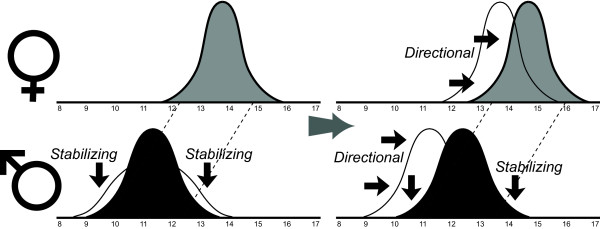Figure 6.
The hypothetical mechanism of how true size-assortative mating, which results from the mechanical constraints, may affect evolution of SSD. Evolutionary changes of the size distribution of males to match the size distribution of females in the manner predicted from the mechanical model (mechanical constraints). Initially, if mechanical constraints on mating are emphasized during evolutionary history, the level of SSD will evolve to a certain size ratio that corresponds to the optimal male grasping posture. During this process, size distribution of males converges, under directional selection, to the new preferable body size determined by the size distribution of females. After the complete convergence, "stabilizing selection" maintains size dimorphism by causing lower fitness of males outside of the optimal body size region. If, for any reason, the size distribution of females undergoes evolutionary shifts then the size distribution of males follows by reaching a new optimal range, matched to the new female size distribution.

